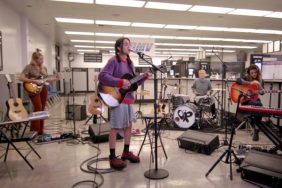Rodrigo Valenzuela, “Sin Héroes”, 2016.
Rodrigo Valenzuela traverses futuristic ruins in his solo exhibition, Sin Héroes. Even though his work appears to be from “the future,” there’s another conversation happening here about the labor needed to make art. In this way, the working mentality of the middle class and working class dominate the underpinnings of his constructed spaces.
In the front gallery, viewers find an array of large-scale photographs of these spaces. There are both meta and mythical qualities to each of the striking photographs; one wonders if the original structures used to make the photographs still exist somewhere, and if so what state they might be in. If so, there’s still garbage in the future.

Rodrigo Valenzuela, “Animita No. 2” (2016). Photo by Lee Thompson.
In “Animita No. 2” (2016), for example, a few plants appear swaying to one side above a layered room interjected by jutting boards and halo-invoking lights. The temple-like walls appear firm but fragile; there’s a possibility that they may crumble at any moment — or perhaps this is a view of the heavens already collapsing. “Animata No. 14” (2016) suggests another variation on this scene. These tricky images offer so many variables within that one could assume they’re completely digitally manipulated, or they’re photograms, or neither. It’s enough to leave one wondering but also being okay with not knowing.
Also: Secret Histories | The Dark Side of “The American Dream”
Valenzuela brings a philosophical bent to his work as well (he holds a BA in philosophy from the Evergreen State College), which folds into the conceptual premise of the work as well:
“To me, what is interesting about making this work is not the story of why Sisyphus is pushing a rock up the hill, or what happens once he reaches the top, but rather what he is thinking while he is pushing that rock.”
With that in mind, would it be interesting to make art out of the thoughts that go through domestic labors’ minds while they are working? Valenzuela actually did do that in his 17-minute video “Maria TV” (2014 ), which screens on a loop at the back of the gallery. In this video, he asks Latina domestic workers (nannies and maids) to talk about their lives and their stories. He asks them about how they came to the U.S., their hopes and aspirations, and their thoughts about wanting to stay or eventually return home.

Installation view. Photo by Lee Thompson.
At certain points in the video, all of the women wear the same outfits, suggesting a uniformity in this specific immigrant narrative. Certain lines sound like they are lifted straight from a soap opera or reality TV, while others offer a more documentary feel; though the quality of this video could be sharper, the lo-fi look of it offers a homemade sensibility that further suggests little separation between subject and object, viewer and performer. At the same time, the viewer is also forced to pause and consider the problematic representations of Latina domestic workers in TV; mostly, they are usually “the help,” represented as adjacent or supporting characters that are not the focus of the narrative.

Rodrigo Valenzuela, “Animita No. 14” (2016). Photo by Lee Thompson. Courtesy of Klowden Mann.
To bring it back to Los Angeles, the conceptual premise for Valenzuela’s work reminds me of a home that I watch being built on Silver Lake Boulevard. Every time I walk by, I see construction workers building the frame into the side of this hill. One day this will be a beautiful home overlooking the boulevard, and the hands of the workers who built it will be all but invisible. The frame will not be visible underneath the structure itself. In Valenzuela’s work, he re-exposes this type of frame, questioning the very structures that it represents, and the process behind it all.





